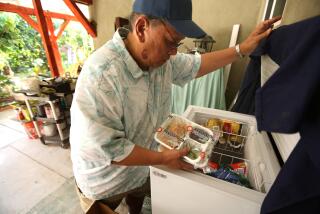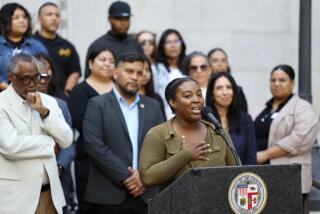3 Single Mothers Get on the Road Off Welfare
- Share via
The first thing Kelly Phillips did was throw her two kids in the car and head out for tacos.
“Our big night out,” she joked.
But it was.
For Phillips, who has spent the past two years on welfare, the car is her ticket to a good job and a better life for Jimmy, 4, and Arie, 6.
The Simi Valley woman is one of three single mothers selected for an innovative Ventura County welfare-to-work program that uses county money to guarantee car loans.
With a four-year loan through the Ventura County Federal Credit Union, Phillips will pay $63 a month to buy and insure her 1986 Chevy Cavalier, a donated county fleet car with a low “blue book” value of $1,850.
“There’s no way I could have walked onto a lot to get a car,” Phillips said. “They would have told me I was crazy. They would have laughed me off the lot.”
She will use the car to get to a computer class that she plans to complete in June. Her dream is to run a five-star hotel, but in the meantime, she’ll settle for a data-entry job and an income that can support her and her children.
That’s exactly what the Ventura County Board of Supervisors had in mind in December when it approved the pilot program designed to help usher welfare recipients off the dole and into self-sufficiency.
Transportation is one of the biggest obstacles that welfare recipients face as they try to comply with the terms of state and federal welfare reform legislation, which in most cases now limits public aid to two years, county officials say.
Most jobs are in eastern Ventura County, while most of the welfare recipients live in the west county. And night and weekend shifts in the suburbs often do not jibe with county bus schedules, especially when a stop at the child-care provider is required on the way to and from work.
In Ventura, Los Angeles, San Bernardino, Riverside and Orange counties, just 25% of the people receiving public aid own cars, according to the Southern California Assn. of Governments. Only about three in 10 can rely on public transportation, carpools or vanpools.
“Counties throughout the country are struggling with this because transportation is one of the biggest unsolved problems for people on welfare,” said Jim Becker, the administrative officer in the county’s Human Services Agency coordinating the pilot program.
Although rare, the county’s new welfare-to-work program is not unprecedented.
*
Anne Arundel County in Maryland, for example, began a similar “Wheels to Work” program several years ago. Recipients there are issued lump-sum welfare grants to repair, register and insure cars donated to local charities as tax write-offs.
Thirty cars have been provided to welfare recipients, and only two of them have returned to the welfare rolls, said Vesta Kimble, deputy director of the state social services office in Anne Arundel County.
The new Ventura County program differs, however, in that it requires welfare recipients to pay for the cars, a stipulation created in part by criticism that the program was just another form of welfare, Becker said.
Carol A. Harris, president and chief executive officer of the county credit union, stresses that the payment terms of the three loans issued for the pilot program are the same that anyone would receive. The only difference is that the county is standing in the shadows, guaranteeing all the loans.
“It’s a great opportunity for them to become financially independent,” said Harris, beaming as Phillips’ two children played in the credit union’s frontyard. “It just really makes me proud to be part of it.”
*
The program was the brainchild of Ron Stark, a part-time aide in Supervisor Frank Schillo’s office who remembered devising a similar plan as a credit union manager in Los Angeles County 30 years ago.
The oil embargo--and rising gas prices--stymied the plan, but he dusted if off when Ventura County began discussing welfare reform.
So far, the county has set aside $7,000 to guarantee the three car loans, which officials admit are just a drop in the bucket.
The three women who received cars this week were chosen from a list of 25 names submitted by social workers. The county evaluated their driving records and credit reports before agreeing to guarantee the loans.
Still, as many as half of the 8,600 county families on welfare do not have reliable cars. Officials are now applying for a $2.2-million federal grant to provide vanpools and other means of transportation for welfare recipients.
Eventually, the county plans to transfer the loan program to a nonprofit agency, which could take in donated cars, repair them and sell them to recipients.
Used-car donors would get a tax write-off, the charity would get a needed source of income, and the welfare recipient would get the keys.
Harris said the credit union could establish a special fund and siphon off a portion of the interest payments that program participants are making. With enough loans going, she said, “this could be a self-insured program” with no need for a guarantee from the county or a nonprofit group.
*
Phillips has been receiving public aid since a breakup with her boyfriend left her with no car, no job and two toddlers to care for.
She said the car, which she will pay for with a portion of her monthly welfare check until she gets a job, will free her from depending on friends, relatives and bus schedules for rides. And it should open the door to better-paying jobs.
“I’m dying to get off welfare,” the Simi Valley native said. “I never wanted to get on in the first place.”
After working for months to put people behind the wheels of the three cars--two of them donated by Bank of America--Schillo beamed as Phillips and her children jumped in the car Wednesday and talked about a trip to Sea World.
“This is like a moment for me, to actually see a human that actually has high expectations for the future,” Schillo said. “Now she has the ability to get someplace, not only to her class but to a job. She has the whole world as her oyster. That almost brings tears to my eyes.”
Correspondent Jason Takenouchi contributed to this story.
More to Read
Sign up for Essential California
The most important California stories and recommendations in your inbox every morning.
You may occasionally receive promotional content from the Los Angeles Times.










